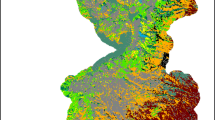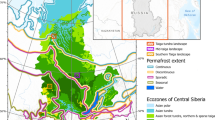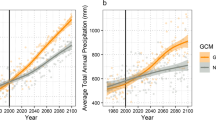Abstract
In the southern California foothills and mountains, pronounced and complex topographic gradients support fire regimes that vary over short distances. We used LANDIS, a spatially explicit landscape model of disturbance and plant succession, to examine the resilience of dominant plant species, representing different disturbance response strategies, to the effect of varying fire rotation intervals (FRI). The simulated fire regimes represented natural, current and very long FRIs for the foothill shrublands less than 1,400 m (90, 30 and 150 years) and montane forest greater than 1400 m (30, 150, 500 years). The 30-year FRI allowed obligate resprouting shrubs to dominate over obligate seeders, whereas the 90-year FRI resulted in a stable spatial distribution of both of these shrub functional types. This is consistent with the literature that suggests that shifts in shrubland composition are most likely to result from human-caused increases in fire frequency at the low-elevation urban-wildland interface. An ecotone conifer, Pinus coulteri, showed dramatic shifts in distribution under different FRIs, and retreated to the portion of the landscape representing its temporal regeneration niche. Both low and high frequency fire maintained the fire tolerant dominant pine (P. jeffreyi) in the montane zone. This contradicts the literature that suggests that a high frequency ground fire regime is required for the persistence of a pine-dominated forest, but is consistent with studies showing that conifer forests in the western U.S. have experienced, and are resilient to, a broad range of natural FRIs that include low frequency, high intensity crown fires.







Similar content being viewed by others
References
Allen CD, Savage M, Falk DA, Suckling KF, Swetnam TW, Schulke T, Stacey PB, Morgan P, Hoffman M, Klingel JT. 2002. Ecological restoration of southwest Ponderosa pine ecosystems: a broad perspective. Ecol Appl 12:1418–33
Baker WL, Ehle D. 2001. Uncertainty in surface-fire history: the case of ponderosa pine forest in the western United States. Can J Forest Res 31:1205–26
Bolton RB, Vogl RJ. 1969. Ecological requirements of Pseudotsuga macrocarpa (Vasey) Mayr. in the Santa Ana Mountains. J Forestry 69:112–9
Borchert M. 1985. Serotiny and cone-habit variation in populations of Pinus coulteri (Pinaceae) in the southern Coast Ranges of California. Madroño 32:29–48
Davis FW, Quattrochi DA, Ridd MK, Lam NS-N, Walsh SJ, Michaelson JC, Franklin J, Stow DA, Johannsen CJ, Johnston CA. 1991. Environmental analysis using integrated GIS and remotely sensed data: some research needs and priorities. Photogramm Eng Remote Sens 57:689–97
De Groot WJ, Bothwell PM, Carlsson DH, Logan KA. 2003. Simulating the effects of future fire regimes on western Canadian boreal forests. J Veg Sci 14:355–64
Ehle D, Baker WL. 2003. Disturbance and stand dynamics in ponderosa pine forests in Rocky Mountain National Park, USA. Ecol Monogr 73:543–66
Franklin J. 2002. Enhancing a regional vegetation map with predictive models of dominant plant species in chaparral. Appl Veg Sci 5:135–46
Franklin J. 2003. Clustering versus regression trees for determining Ecological Land Units in the southern California mountains and foothills. Forest Sci 49:354–68
Franklin J, Coulter C, Rey SJ. 2004. Change over 70 years in a southern California chaparral community related to fire history. J Veg Sci 15:701–710
Franklin J, Syphard AD, Martin RM, Mladenoff DJ, He HS, Simons DK, Deutschman D. 2001. Simulating the effects of different fire regimes on plant functional types in southern California. Ecol Model 142:261–83
Franklin J, Woodcock CE, Warbington R. 2000. Multi-attribute vegetation maps of Forest Service lands in California supporting resource management decisions. Photogramm Eng Remote Sens 66:1209–17
Gordon H, White TC. 1994. Ecological guide to southern California chaparral plant series. San Diego, CA: USDA Forest Service, Pacific Southwest Region. p 162
Haidinger TL, Keeley JE. 1993. Role of high fire frequency in destruction of mixed chaparral. Madroño 40:141–7
Hanes TL. 1971. Succession after fire in the chaparral of Southern California. Ecol Monogr 41:27–52
Hansen AJ, di Castri F, editors. 1992. Landscape boundaries: consequences for biotic diversity and ecological flows. Berlin Heidelberg, New York: Springer
He HS, Mladenoff DJ. 1999a. The effects of seed dispersal on the simulation of long-term forest landscape change. Ecosystems 2:308–19
He HS, Mladenoff DJ. 1999b. Spatially explicit and stochastic simulation of forest-landscape fire disturbance and succession. Ecology 80:81–90
He HS, Mladenoff DJ, Boeder J. 1999a. An object-oriented forest landscape model and its representation of tree species. Ecol Model 119:1–19
He HS, Mladenoff DJ, Crow TR. 1999b. Linking an ecosystem model and a landscape model to study forest species response to climate warming. Ecol Model 114:213–33
He HS, Mladenoff DJ, Radeloff VC, Crow TR. 1998. Integration of GIS data and classified satellite imagery for regional forest assessment. Ecol Appl 8:1072–83
Holland MM, Risser PG, Naiman RJ. 1991. Ecotones. New York: Chapman and Hall
Host GE, Polzer PL, Mladenoff DJ, White MA, Crow TR. 1996. A quantitative approach to developing regional ecosystem classifications. Ecol Appl 6:608–18
Jenkinson JL. 1990. Jeffrey Pine. In: Burns RM, Honkala BH (Eds). Silvics of North America: 1. Conifers; 2. Hardwoods. Washington (DC): US Department of Agriculture, Forest Service. p 877
Johnson EA. 1992. Fire and vegetation dynamics, studies from the North American boreal forest. Cambridge, UK: Cambridge University Press
Johnson EA, Gutsell SL. 1994. Fire frequency models, methods and interpretations. Adv Ecol Res 25:239–86
Keeley JE. 1977. Seed production, seed populations in soil, and seedling production after fire for two congeneric pairs of sprouting and nonsprouting chaparral shrubs. Ecology 58:820–9
Keeley JE. 1981. Reproductive cycles and fire regimes. In: Proceedings of the Conference Fire Regimes and Ecosystem Properties, General Technical Report WO-26. Washington: USDA. p 231–77
Keeley JE. 1986. Resilience of mediterranean shrub communities to fire. In: Dell B, Hopkins AJM, Lamont BB (Eds). Resilience in Mediterranean-type ecosystems. Dordrecht: Dr W. Junk. p 95–112
Keeley JE 1992a. Demographic structure of California chaparral in the long-term absence of fire. J Veg Sci 3:79–90
Keeley JE 1992b. Recruitment of seedlings and vegetative sprouts in unburned chaparral. Ecology 73:1194–208
Keeley JE. 2000. Chaparral. In: Barbour MG, Billings WD (Eds). North American terrestrial vegetation. Cambridge: Cambridge University Press. p 204–53
Keeley JE. 2001. Fire and invasive species in mediterranean-climate ecosystems of California. In: Galley KEM, Wilson TP (Eds). Proceedings of the invasive species workshop: the role of fire in the control and spread of invasive species. Fire Conference 2000: the First National Congress on Fire Ecology, Prevention and Management. Misc. Publ. No. 11. Tallahassee (FL): Tall Timbers Research Station. pp 81–94
Keeley JE 2002. Native American impacts on fire regimes of the California coastal ranges. J Biogeogr 29:303–20
Keeley JE, Fotheringham CJ. 2001. Historical fire regime in southern California shrublands. Conserv Biol 15:1536–48
Keeley JE, Fotheringham CJ. 2003. Impact of past, present, and future fire regimes on North American mediterranean shrublands. In: Veblen TT, Baker WL, Montenegro G, Swetnam TW (Eds). Fire and climate change in temperate ecosystems of the western Americas. Berlin Heidelberg, New York: Springer. pp 218–62
Keeley JE, Fotheringham CJ, Morias M. 1999. Reexamining fire suppression impacts on brushland fire regimes. Science 284:1829–32
Keeley JE, Keeley SC. 1986. Chaparral and wildfires. Fremontia 14:18–21
Keeley JE, Swift CC. 1995. Biodiversity and ecosystem functioning in Mediterranean-climate California. In: Davis GW, Richardson DM (Eds). Biodiversity and function in mediterranean-type ecosystems. Berlin Heidelberg, New York: Springer. p 121–83
Keeley JE, Zedler PH. 1978. Reproduction of chaparral shrubs after fire: a comparison of sprouting and seeding strategies. Am Midl Nat 99:142–61
Keeley JE, Zedler PH. 1998. Evolution of life histories in Pinus. In: Richardson DM (Eds). Ecology and biogeography of Pinus. Cambridge, UK: Cambridge University Press. pp 219–51
Laacke RJ. 1990. Abies concolor. In: Burns RM, Honkala BH (Eds). Silvics of North America: 1. Conifers; 2. Hardwoods. Washington (DC): US Department of Agriculture, Forest Service. pp 877
Levin SA 1992. The problem of pattern and scale in ecology. Ecology 73:1943–67
Lewis HT. 1973. Patterns of Indian burning in California: ecology and ethnohistory. Ramona, California: Ballena Press. p 101
Mack MC, D’Antonio CM. 1998. Impacts of biological invasions on disturbance regimes. Trends Ecol Evol 13:195–8
McBride JR, Laven RD. 1976. Scars as an indicator of fire frequency in the San Bernardino Mountains, California. J Forestry 74:439–42
McDonald PM. 1990. Bigcone Douglas-Fir. In: Burns RM, Honkala BH (Eds). Silvics of North America: 1. Conifers; 2. Hardwoods. Washington (DC): US Department of Agriculture, Forest Service. pp 877
Mensing SA, Michaelsen J, Byrne R. 1999. A 560-year record of Santa Ana fires reconstructed from charcoal deposited in the Santa Barbara Basin, California. Quaternary Res 51:295–305
Miles SR, Goudey CB. 1997. Ecological subregions of California: section and subsection descriptions. R5-EM-TP-005. San Francisco, CA: USDA Forest Service, Pacific Southwest Region
Minnich RA 1988. The biogeography of fire in the San Bernardino Mountains in California: a historical study. Univ Calif Publ Geogr 27:1–121
Minnich RA 1991. Conifer forest fire dynamics and distribution in the mountains of southern California, part 1. Crossosoma 17:1–11
Minnich RA. 1999. Vegetation, fire regimes, and forest dynamics. In: Miller PR, McBride JR (Eds). Oxidant air pollution impacts in the montane forests of southern California: a case study of the San Bernardino Mountains. Berlin Heidelberg, New York: Springer. pp 44–78
Minnich RA 2001. An integrated model of two fire regimes. Conserv Biol 15:1559–3
Minnich RA, Barbour MG, Burk JH, Fernau RF. 1995. Sixty years of change in Californian conifer forests of the San Bernardino Mountains. Conserv Biol 9:902–14
Minnich RA, Chou YH. 1997. Wildland fire patch dynamics in the chaparral of southern California and northern Baja California. Int J Wildland Fire 7:221–48
Mladenoff DJ, Baker WL. 1999. Spatial modeling of forest landscape change. Cambridge, UK: Cambridge University Press
Mladenoff DJ, He HS. 1999. Design, behavior and application of LANDIS, as object-oriented model of forest landscape disturbance and succession. In: Mladenoff DJ, Baker WL (Eds). Spatial modeling of forest landscape change: approaches and applications. Cambridge: Cambridge University Press. pp 125–62
Mladenoff DJ, Host GE, Boeder J, Crow TR. 1996. LANDIS: a spatial model of forest landscape disturbance, succession, and management. In: Goodchild MF, Steyaert LT, Parks BO (Eds). GIS and environmental modeling: progress and research issues. Ft. Collins, CO: GIS World, Inc. pp 175–9
Mooney HA 1977. Frost sensitivity and resprouting behavior of analogous shrubs of California and Chile. Madroño 24:74–8
Moritz MA 1997. Analyzing extreme disturbance events: fire in Los Padres National Forest. Ecology 7:1252–62
Moritz MA 2003. Spatiotemporal analysis of controls on shrubland fire regimes: age dependency and fire hazard. Ecology 84:351–61
Noble IR, Slatyer RO. 1980. The use of vital attributes to predict successional changes in plant communities subject to recurrent disturbances. Vegetatio 43:5–21
O’Leary JF. 1990. California coastal sage scrub: general characteristics and consideration for biological conservation. In: Schoenherr AA (Eds). Endangered plant communities of southern California. Fullerton: Southern California Botanists. pp 24–44
Parker TV, Kelly VR. 1989. Seed banks in California chaparral and other Mediterranean climate shrublands. In: Leck MA, Parker VT, Simpson RL (Eds). Ecology of soil seed banks. New York: Academic Press. pp 231–55
Pausas JG 1999. Response of plant functional types to changes in the fire regime in Mediterranean type ecosystems: a simulation approach. J Veg Sci 10:717–22
Pausas JG 2003. The effect of landscape pattern on Mediterranean vegetation dynamics: a modelling approach using functional types. J Veg Sci 14:365–74
Pausas JG, Bradstock RA, Keith DA, Keeley JE. 2004. Plant functional traits in relation to fire in crown fire ecosystems. Ecology 85:1085–110
Pausas JG, Lavorel S. 2003. A hierarchical deductive approach for functional types in disturbed ecosystems. J Veg Sci 14:409–16
Pickett STA, White PS. 1985. The ecology of natural disturbance and patch dynamics. New York: Academic Press
Prescribed Fire and Fire Effects Research Work Unit Rocky Mountain Research Station (FEIS). 1996. Fire Effects Information System [Online]. http://www.fs.us/database/feis
Roberts DW 1996. Modeling forest dynamics with vital attributes and fuzzy systems theory. Ecol Model 90:161–73
Sawyer JO, Thornburgh DA. 1988. Montane and subalpine vegetation of the Klamath Mountains. In: Barbour MG, Major J (Eds). Terrestrial Vegetation of California. Davis (CA): CNPS Press. pp 699–732
Stephenson J, Calcarone GM. 1999. Southern California mountains and foothills assessment: habitat and species conservation issues. Albany (CA): General Technical Report PSW-GTR-172, USDA Forest Service, Pacific Southwest Research Station. p 402
Syphard AD, Franklin J. 2004. Spatial aggregation effects on the simulation of landscape pattern and ecological processes in southern California plant communities. Ecol Model 180:21–40
Turner MG, Costanza R, Sklar FH. 1989. Methods to evaluate the performance of spatial simulation models. Ecol Model 48:1–18
Vander Wall SB. 1992. The role of animals in dispersing a “wind-dispersed” pine. Ecology 73:614–21
Vogl RJ, Schorr PK. 1972. Fire and manzanita chaparral in the San Jacinto Mountains, California. Ecology 53:1179–88
Wear DN, Turner MG, Flamm RO. 1996. Ecosystem management with multiple owners: landscape dynamics in a southern Appalachian watershed. Ecol Appl 6:1173–88
Wells ML. 2001. Human-altered fire regimes and the development of stand structure in Macrocarpae pines [Ph.D. Dissertation]. San Diego (CA): San Diego State University and U. C. Santa Barbara. p 149
Wells ML, O’Leary JF, Franklin J, Michaelsen J, McKinsey DE. 2004. Variations in a regional fire regime related to vegetation type in San Diego County, California (USA). Landscape Ecol 19:139–52
Wells PV. 1969. The relation between mode of reproduction and extent of speciation in woody genera of the California chaparral. Evolution 23:264–7
Wolter PT, Mladenoff DJ, Host GE, Crow TR. 1995. Improved forest classification in the Northern Lake States using multi-temporal Landsat imagery. Photogramm Eng Remote Sens 61:1129–43
Zammit CA, Zedler PH. 1992. Size structure and seed production in even-aged populations of Ceanothus greggii in mixed chaparral. J Ecol 81:499–511
Zedler PH. 1995a. Fire frequency in southern California shrublands: biological effects and management options. In: Scott TA (Eds). Brushfires in California wildlands: ecology and resource management. Fairfield (WA): International Association of Wildland Fire. pp 101–12
Zedler PH. 1995b. Plant life history and dynamic specialization in the chaparral/coastal sage scrub flora in southern California. In: Fox MD (Eds). Ecology and Biogeography of Mediterranean Ecosystems in Chile, California, and Australia. Berlin Heidelberg, New York: Springer. pp 89–115
Zedler PH, Zammit CA. 1989. A population-based critique of concepts of change in the chaparral. In: Keeley SC (Eds). The California chaparral: paradigms reexamined. Los Angeles: Natural History Museum of Los Angeles County. pp 73–83
Acknowledgements
This work was supported by the National Science Foundation under grant no. 9818665 (to JF) and a NASA ESS fellowship (to ADS). Any opinions, findings, and conclusions or recommendations expressed in this material are those of the authors and do not necessarily reflect the views of NSF or NASA. JF and ADS thank D. Apalatea and C. Coulter for their assistance, and J. Keeley, C. J. Fotheringham, P. Zedler and M. Wells for their insights. The manuscript was greatly improved by the comments of D. DeAngelis and the anonymous reviewers.
Author information
Authors and Affiliations
Corresponding author
Rights and permissions
About this article
Cite this article
Franklin, J., Syphard, A.D., He, H.S. et al. Altered Fire Regimes Affect Landscape Patterns of Plant Succession in the Foothills and Mountains of Southern California. Ecosystems 8, 885–898 (2005). https://doi.org/10.1007/s10021-005-0017-6
Received:
Accepted:
Published:
Issue Date:
DOI: https://doi.org/10.1007/s10021-005-0017-6




